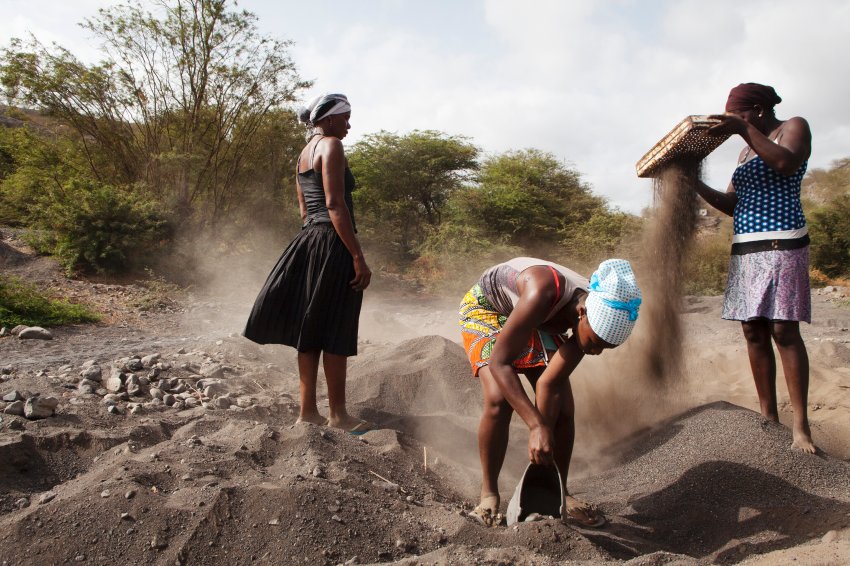The Sand Thieves: World’s Beaches Become Victims of Construction Boom
Sand is becoming so scarce that stealing it has become an attractive business model. With residential towers rising ever higher and development continuing apace in Asia and Africa, demand for the finite resource is insatiable.
spiegel.de : Women separate and make piles of sand in Cape Verde. Many of the island nation’s beaches have disappeared as a result of sand mining. The natural resource has become rarer around the globe due to the rise of industrialized nations and a boom in construction in emerging nations like China and India. For many in Cape Verde, it is the sole source of income.
It’s during the few hours when the sea retreats and reveals its underlying treasure that the people come. At first they appear like ants, small dots on the mountain slope, but the group, perhaps 100, quickly draws closer. The men carry shovels, and the women, buckets. They’ve come to steal Cape Verde’s sand.
A young man jumps into the ocean and wades a few meters out. The water rises up to his chest. He dives under, and when he returns to the surface, his sludgy bounty drips from his shovel.
He energetically shovels the mass into a bucket held by a woman waiting next to him. As she lifts the heavy bucket onto her head, she pauses for a moment, closing her eyes. A wave hits from behind and rolls over her. Once it passes, she clenches her teeth as she wades back to shore.
The sand robbers are in a hurry. The ebb here lasts six hours and they can only mine the sand during low tide. Very few of the people here can swim, and the task can be life-threatening even at low tide as the waves break over their heads and the currents tug at their legs.
They rush back and forth. Some are still youthful, but others are over 50. A heavily pregnant woman climbs out of the water, another grabs her hand to help her along. They come here every day, they say. “Except Sundays. On Sundays we go to church.”
Disappearing Sands
The sand has long since disappeared from the high-tide shorelines at beaches like this, with only dirt and stones left to mark the coastline. Once the sand disappeared on the shore, the people began venturing into the water to find it. They’ve since been mining away their island’s sand, one bucket at a time.
Diminutive Cape Verde, located around 600 kilometers (373 miles) west of Senegal, is comprised of nine inhabited islands in the Atlantic Ocean formed by volcanoes. It’s a beguiling land, one where papayas, mangos and pineapples grow between canyons. The sun shines year-round, the waters of the Atlantic foam on its shores and rare turtles bury their eggs on beaches. Cape Verde is considered one of the safest and most stable regions in Africa. It would be a dream destination for tourists if it weren’t for the fact that the Cape Verdeans are hard at work destroying their beaches.
Of course, there are still intact shorelines on Cape Verde — places where luxury hotels serve guests from Italy, Germany and Portugal. But in other areas, the beaches are disappearing.
From a distance, it looks like gophers have dug their way through the beaches, with piles of sand stacked up, still dark from the wetness. Between them, stones are scattered, having been separated from the sand. And there are several pits, some as deep as two meters.
A Global Problem
The phenomenon of disappearing beaches is not unique to Cape Verde. With demand for sand greater than ever, it can be seen in most parts of the world, including Kenya, New Zealand, Jamaica and Morocco. In short, our beaches are disappearing. “It’s the craziest thing I’ve seen in the past 25 years,” says Robert Young, a coastal researcher at Western Carolina University. “We’re talking about ugly, miles-long moonscapes where nothing can live anymore.”
The sand on our ocean shores, once a symbol of inexhaustibility, has suddenly become scarce. So scarce that stealing it has become attractive.
Never before has Earth been graced with the prosperity we are seeing today, with countries like China, India and Brazil booming. But that also means that demand for sand has never been so great. It is used in the production of computer chips, plates and mobile phones. More than anything, though, it is used to make cement. You can find it in the skyscrapers in Shanghai, the artificial islands of Dubai and in Germany’s autobahns.
‘Sand Is Like Oil, It Is Finite’
In 2012, Germany alone mined 235 million tons of sand and gravel, with 95 percent of it going to the construction industry. The United Nations Environment Program (UNEP) estimates global consumption at an average of 40 billion tons per year, with close to 30 billion tons of that used in concrete. That would be enough to build a 27-meter by 27-meter (88.5 feet) wall circling the globe. Sands are “now being extracted at a rate far greater than their renewal,” a March 2014 UNEP report found. “Sand is rarer than one thinks,” it reads.
At times, the paucity of sand has even forced workers to put down their tools at construction sites in India and China. It has also halted fracking-related drilling in the United States because the process requires that sand be mixed in with the water pumped into the ground in order to keep open the fissures from which gas is extracted.
“Sand is like oil,” explains Klaus Schwarzer, a geoscientist at Germany’s University of Kiel. “It is finite.” Western Carolina University’s Young adds, “If we’re not careful, we’ll run out of sand.”
Difficult Lessons in Cape Verde
The people of Cape Verde are already learning the hard way what can happen when the sand starts to disappear.
In Ribeira da Barca, the small town where the sand thieves come from, fishermen store their boats in the streets. A pack of dogs snoozes in the shadows. A few steps further, town official Jerónimo Oliveira stands at the shore, his hands clasped behind his back. He tries to explain how the situation could have progressed this far.
When he was around six years old, Oliveira recalls, he could still play on the beach. Today, though, the black sand has been replaced by ocean. The remains of a wall jut out between the waves. “One day, one of the houses collapsed,” he says, its foundation having become instable. “It probably won’t be the last,” he adds.
The sand had protected the town from the water like a dike. But once the beach began to shrink, the ocean devoured the remaining sand at an ever faster pace, taking a little more with each wave and passing storm. Today the surf gnaws at the foundations of homes, with the climbing sea level and erosion intensifying the effect.
As the problem began to grow, residents asked the government for help. Now, a wall runs along the shoreline — made of concrete.
Oliveira shakes his head. Although he says he doesn’t want to defend the sand thieves, he also doesn’t want to condemn them. He explains that 4,000 people live in the town and that not even 20 have steady jobs.
Even though Praia, the capital of Cape Verde, is booming, Ribeira da Barca is an impoverished town. The rule of thumb here is that those who have money buy sand. Those who do not sell it. The same applies in Hong Kong, Singapore, Indonesia and Cambodia. And, as geologist Harald Dill of the University of Hanover says: “Small city-states have a tendency to dig away the coasts of weaker countries.”
Efforts to Stop Illegal Mining Fail
In 2012, the environmental organization Global Witness released satellite images showing how Singapore has expanded its territory by 22 percent over the past 50 years. The group provided evidence that the sand used to enlarge Singapore came from neighboring countries like Vietnam, Indonesia and Malaysia and had, in some instances, been extracted illegally. One country after the other then issued a ban on mining sand. Singaporean dredging vessels responded by setting course for Cambodia. Phnom Penh responded by likewise banning exports of the resource.
Prospecting for sand has also been prohibited in Cape Verde since 2002 and the military does in fact patrol parts of the coastline for illegal mining activity. Sometimes they even arrest sand thieves, but the punitive measures have thus far done little to stop illicit trade.
Clarisse Tavares Borges, who goes by “Dita,” has herself been detained for sand theft. She spent 24 hours in jail with five other women. She is sitting on a plastic chair in her home with the curtains billowing in the wind. The crashing of Atlantic waves can be heard in the distance. There’s china in a cabinet on the wall and the floor has been swept clean. The 38-year-old apologetically says she can’t get up because she’s suffered from back pain for years now. Bending down to get the sand and lifting the buckets is becoming more difficult for her, Dita says.
Her older boys, aged 18 and 11, are perched in front of the house and her 18-month-old toddler is sleeping in the double bed shared by the family. Dita says she dreams that each will one day have their own bed to sleep in.
In the village where Dita lives, sand mining is women’s work. The men either work as fishermen or imbibe grog at the bar. Virtually all the women here, including Dita, are single mothers.
They survive by selling vegetables or mining sand. Each morning the women and their daughters hike the stony path down to the ocean. Dita says they are well aware that their work is damaging to the village. She’s even noticed that the drinking water now tastes saltier and that the mango and papaya trees are shrinking because of saltwater seepage. “We thought the sand would last forever,” she says.

